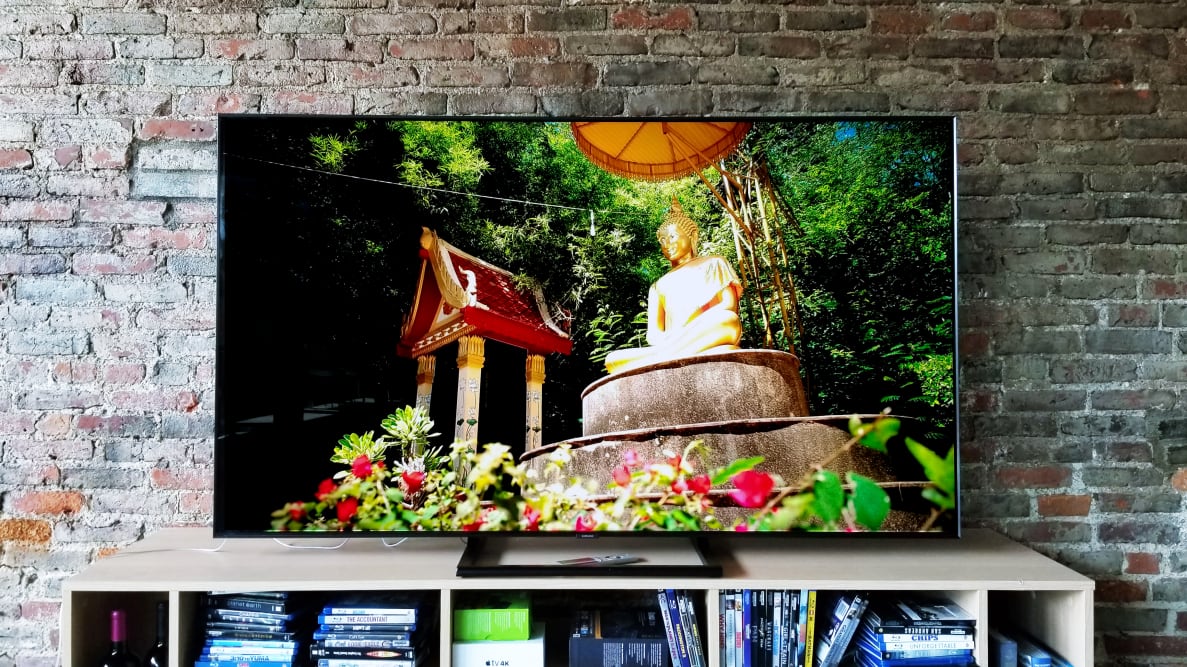Pros
-
Quantum-dot technology
-
Incredible 4K, HDR-compatible picture
-
Better-than-average viewing anglles
Cons
-
Some black-level inconsistency
This is one of Samsung's QLED TVs, meaning its major claim to fame is the use of quantum dot technology to boost its light output and color volume. Available in 65- and 75-inch sizes, both Q9FN models are beautifully designed and equipped with the latest in TV tech. As you might guess, these are expensive, premium-grade TVs.
For what you're paying, though, this is one of the most impressive TVs I've ever seen. While our model had a few small spots where it stumbled, it's pound for pound about as perfect as an LED TV can be in 2018.
About the Samsung Q9FN
{{ amazon name="Samsung QN65Q9F Flat 65" QLED 4K UHD 9 Series Smart TV 2018", asin="B079Z511K2", align="right" }}
The Samsung Q9FN series is available in two screen sizes:
- 65-inch (Samsung QN65Q9FN), $3,799 MSRP
- 75-inch (Samsung QN75Q9FN), $5,999 MSRP
As you can see, not only is the Q9FN series pretty pricy, it's also only available in a couple of screen sizes. The Q9FN TVs deliver the best of Samsung's TV tech for 2018, including:
• 4K (3,840 x 2,160) resolution • Quantum Dot-enhanced color and brightness • Full-Array Local Dimming backlight • High Dynamic Range compatible (HDR10+) • Samsung Smart Hub w/ Bixby • 120 Hz refresh rates • "Invisible" cable OneConnect box • OneRemote remote control • Ambient mode
We received our 65-inch Q9FN on loan from Samsung, and I gave the TV roughly 24 hours to run and settle before watching, testing, and evaluating it. As usual, I also fully factory reset the model prior to taking measurements—just in case.
The Pros
Beautiful from every angle
Samsung is one of the TV companies that puts extra focus on TV design—very successfully, I might add—and as the company's 2018 flagship, the Q9FN is kind of a peacock. It's designed to be supremely sleek and minimal, and it pulls it off.
Despite being a full-array local dimming set, the Q9FN's panel is still compact and fairly thin. The almost bezel-less screen has a seamless, unibody feel: it's not overly heavy, but still feels extremely durable.
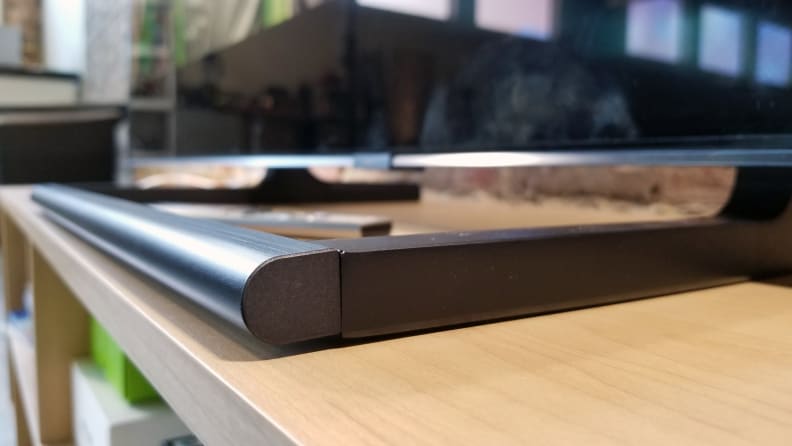
Our Q9FN's included center stand features smooth, brushed metal that's heavy enough to secure the TV panel without taking up much tabletop space.
One neat thing about the Q9FN is that you can get it with a variety of stands. Our loan unit came with the standard rectangular bar prop that fastens in the middle of the TV, but Samsung also has a "Studio" stand, "Gravity" stand, and a unique wall-mount solution called the "No Gap Wall Mount."
The Q9FN also includes the OneConnect box, which adds heavily to its minimalist aesthetic. The OneConnect box is an external house for all of the TV's ports that connects to the rear of the TV's panel via a single "invisible" cable (this all makes a lot more sense when you see it in person).
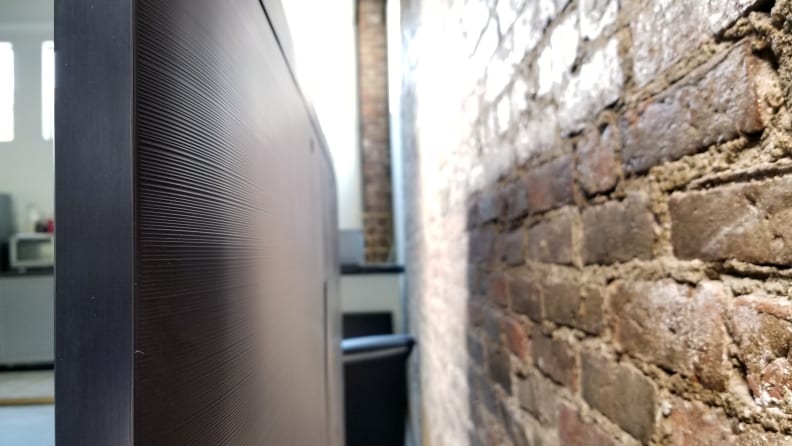
The Q9FN is a bit thicker than the 2017 QLEDs because it uses a full-array LED backlight.
This year's OneConnect box is a big one, too, but for a good reason. It not only houses the TV's four HDMI inputs, three-USB port hub, coaxial, LAN connection, etc., but also serves as a power supply. So while it's definitely bulkier this year, it's also finally living up to its namesake.
The OneRemote continues to be about as stripped down as possible while still serving as a functional clicker. Its curved shape and few-as-possible buttons lend to the TV's air of finely-tooled, premium design. You can also control the TV though Samsung's "SmartThings" app, if you're so inclined.
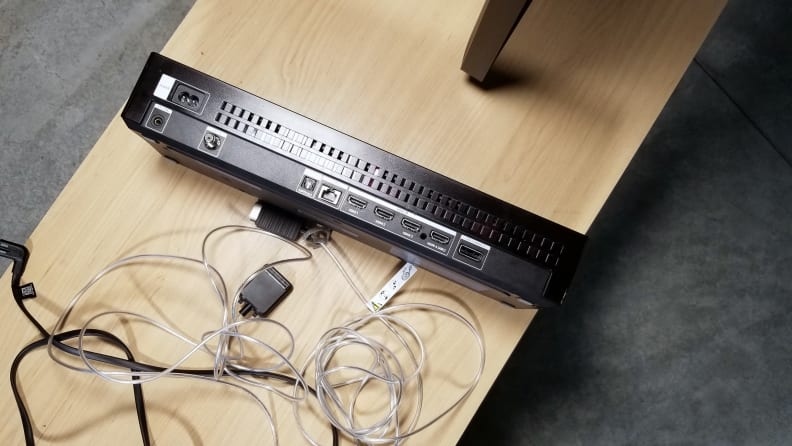
The Q9FN's OneConnect box, which connects to the TV via a long, "invisible" ten-foot cable. The box also provides power to the TV, so definitely don't lose it.
Even more beautiful when you're watching it
The first thing TJ and I did when this TV got dropped off was build it, run through the initial setup, and immediately start watching Thor: Ragnarok on Netflix (which is just delightful, if you haven't seen it).

The TV's normal picture (left) and the effect when "HDR+" is turned on (right)
At first, I turned on the Q9FN's "HDR+" mode, a picture setting that basically gives any content an "HDR" appearance. More literally, it amps up the TV's brightness and color, while scaling the non-HDR content so that it doesn't look too oversaturated or unnatural. It also adds a sharpening effect that every now and again looks a little wonky.
But this was a bit much: both TJ and I were left wincing and shielding our eyes from the Q9FN's unrelenting brightness.

So I switched to Movie mode, turned all the Auto Motion Plus settings off, switched Audio to "Optimized" (during the "Immigrant Song" bit, which is also delightful), set the backlight to the room lighting, and turned the color space to "Auto" to take advantage of those sweet, colorful quantum dots.
And then I totally forgot I was supposed to be reviewing a TV and got sucked right in by Chris Hemsworth's chiseled... performance.
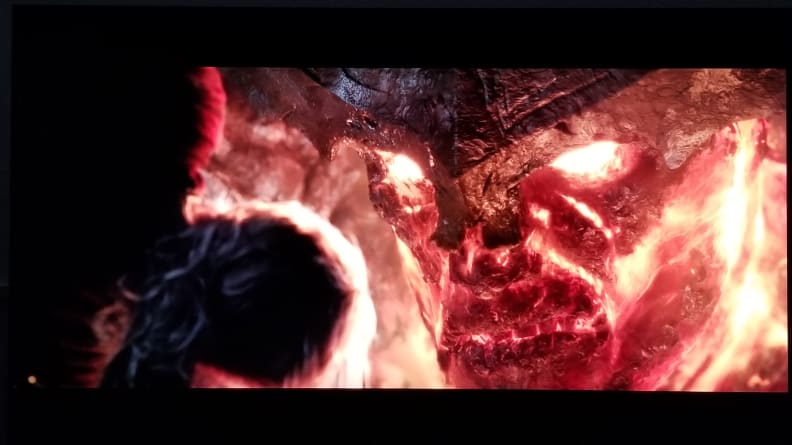
In Movie mode but with the TV's color space set to "Native," Thor had a crisp, natural look with a welcome amount of extra color.
My point is, this TV looks great. It's got enough brightness and color vivacity for a bright room, meaning you can scale it back for dedicated viewing environments, and then pick and choose which aspects to augment or diminish.
The 16:9 black bars were impressively dark, and even the viewing angle—though it looked atrocious during the Netflix boot screen—seemed better than average for an LED TV. The TV's native color rendered everything with a pleasing vividness. Of course, these were all just first impressions.

For a TV with full-array local dimming, the Q9FN has a better horizontal viewing angle than average. It's still not an OLED, but you can wall-mount it without concern.
As I expected, though, our lab tests corroborated the initial experience. The Q9FN evinces excellent contrast and motion performance—its black levels are especially impressive for an LED TV, and some of the HDR brightness numbers we measured had me seriously considering leaving a pair of sunglasses down in the lab.
Relevant Data (Movie mode)
- SDR Contrast: 199.90 / 0.022 nits
- HDR Contrast: 865.8 / 0.09 nits
- HDR APL%: 2%: 343.3 / 10%: 1,617 / 20%: 1,579 / 40%: 1,513 / 50%: 1,246 nits
- HDR DCI-P3: 97% coverage
- Viewing Angle: 46.50° or ±23.25° from center to either side of the screen
Clean, sensible extras
The Q9FN is also equipped with some extra features worth jawing about. The menu interface hasn't changed much from the past couple years. When you hit the "home" button on the remote, the smart features and settings pop up along the bottom quarter of the screen. This is where you'll access apps like Netflix and Spotify; the TV's picture, audio, and network settings; and switch source inputs. It's intuitive enough for anyone to make use of, in my opinion.
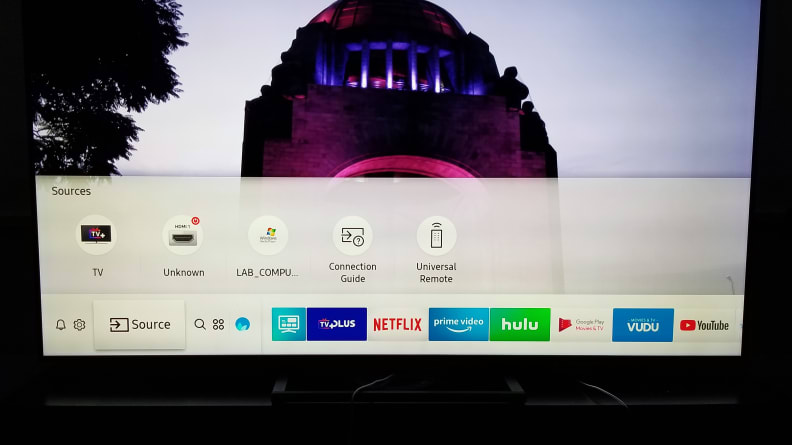
The menu and smart features haven't changed much from last year, but they're still very reliable. We especially like how easy it is to identify and control HDMI devices.
One thing that Samsung's gotten better at year over year is providing TV software that allows the TV to be the center of your home theater or living room, from a device perspective. Plugging in any number of DVD or Blu-ray players, game consoles, and so on prompts the TV to identify the device and then label it within the input list.
For many devices, you'll also be able to automatically control them with the remote one they're identified, which is pretty handy. You might want to keep the original remote nearby though—the OneRemote has so few buttons, it's not always the most robust control option for source devices.
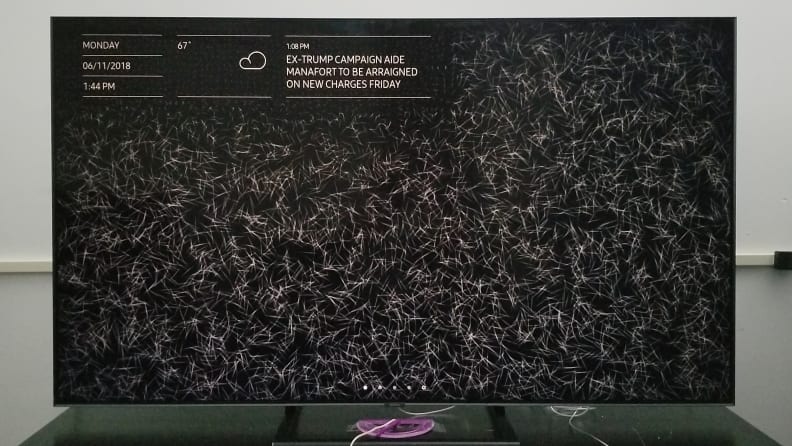
New for 2018, "Ambient mode" allows the TV to display an image, or information about weather or news headlines while it's technically off in a low-power mode.
Finally, the Q9FN TVs have an "Ambient mode" that allows them to display an image and the time or weather while the TV is off. This uses a minimal amount of electricity, but allows the TV to contribute aesthetically to the room it's in, rather than becoming a lifeless black rectangle while you're not using it. It's a simple little addition to the 2018 smart features, but I can't imagine anyone not wanting to use it, either.
The Cons
The TV performs better in HDR than not
This possibility has been on my radar for a little while: a TV that's set up from the factory to perform better during HDR playback than it does during SDR. Without considerably complicated internal components, the transition from standard dynamic range (or SDR) to HDR functionality has usually yielded TVs that are set up to look their best during SDR, and to amp up brightness and color and look as good as possible during HDR playback.
The Samsung Q9FN appears to work a little differently. Testing revealed that it's very well calibrated (in Movie mode) while playing HDR content, but has a few spots in SDR where it doesn't perform all that well. To be fair, this took test patterns and meter measurements to notice, it wasn't anything I noticed during playback, so this is more of a picture quality enthusiast's concern than otherwise, but it's worth noting.

The Q9's calibration during SDR (standard dynamic range) is a bit underwhelming. Its Movie mode is set up well for HDR, but can look a bit washed out during SDR.
Full-array local dimming can cause black level inconsistency
It's generally accepted that TVs with full-array local dimming perform better than their edge-lit LED counterparts. However, with the better contrast performance comes a couple other common hurdles, one of which is inconsistency in black level. Basically, large shadowy areas tend to be a lot darker than smaller shadowy areas, because more (or less) zones can dim down or shut off.
The Q9FN evinces this issue, but like the SDR calibration, it's not really a huge problem unless you're very picky. The meters picked it up, of course, but I can't say I noticed it excessively while actually watching content. Still, it's likely that now and again you may see shadows during content that look a bit "crushed" or don't look dark enough: this is the eternal struggle of a local dimming algorithm that can't possibly predict the perfect expression of every scene it will have to render.
Relevant Data (Movie mode)
- SDR Color Gamut coverage: 93%
- SDR Grayscale dE: 4.99
- SDR 90% black: 0.001 nits
- SDR 10% black: 0.048 nits
- HDR 90% black: 0.002 nits
- HDR 10% black: 0.13 nits
Should You Buy It?
If you're on the hunt for a premium TV in this price range, deciding between the Q9FN and something like LG's C8 OLED series might be a decision you make this year. At around $3,500, those two TVs are neck-and-neck in price and performance.
While we haven't tested LG's C8 just yet, I can at least confirm that the Q9FN has no major drawbacks of any kind. Sure, you're paying a lot for these TVs, but you're getting stellar performance, great design, and very useful features.
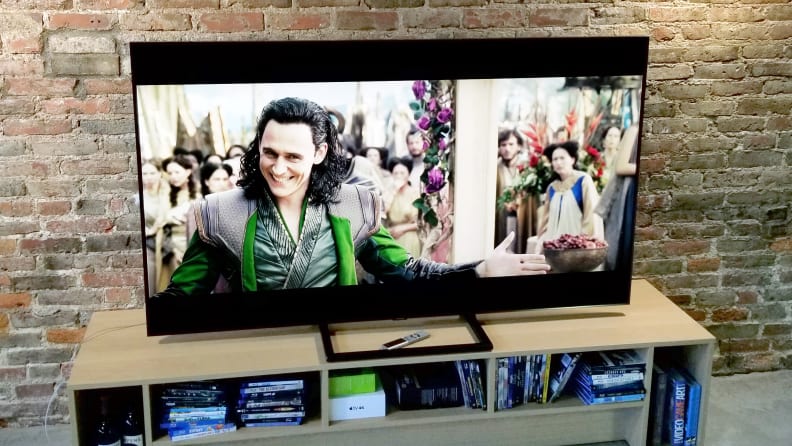
Sometimes a TV's price reflects both its superior picture quality and its excellent design.
While an OLED might be a better choice if you need huge viewing angles or like to watch in total darkness, Samsung's Q9FN is every bit as impressive—in fact, it's a better choice for a brighter room. And if you need a really big screen, the 75-inch Q9FN is $3,000 less expensive than the 77-inch C8 OLED.
At the end of the day, Samsung's 2018 flagship is a—rather literally—shining example of just how awesome LED TVs can be. If you won't settle for anything but ultra-premium performance, keep this one on your radar.
Meet the tester
Lee was Reviewed's point person for most television and home theater products from 2012 until early 2022. Lee received Level II certification in TV calibration from the Imaging Science Foundation in 2013. As Editor of the Home Theater vertical, Lee oversaw reviews of TVs, monitors, soundbars, and Bluetooth speakers. He also reviewed headphones, and has a background in music performance.
Checking our work.
Our team is here to help you buy the best stuff and love what you own. Our writers, editors, and experts obsess over the products we cover to make sure you're confident and satisfied. Have a different opinion about something we recommend? Email us and we'll compare notes.
Shoot us an email
